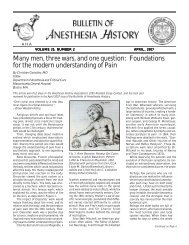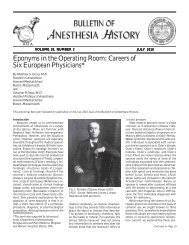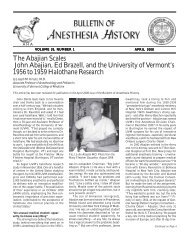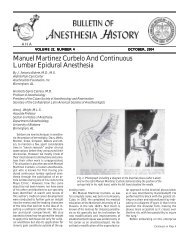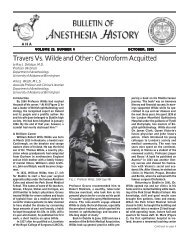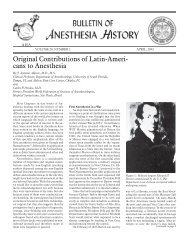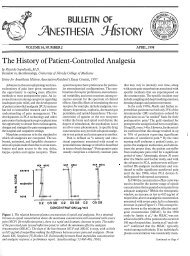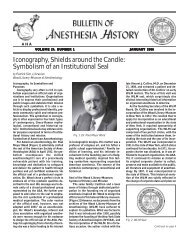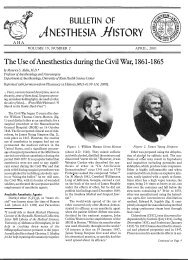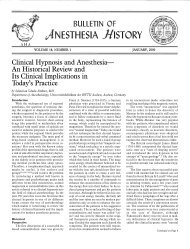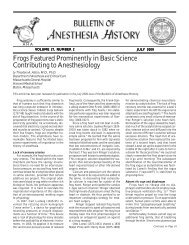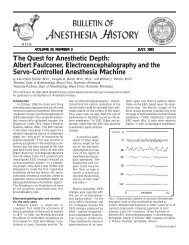April 2011 - Anesthesia History Association
April 2011 - Anesthesia History Association
April 2011 - Anesthesia History Association
You also want an ePaper? Increase the reach of your titles
YUMPU automatically turns print PDFs into web optimized ePapers that Google loves.
20 20<br />
BULLETIN BULLETIN OF OF ANESTHESIA ANESTHESIA HISTORY<br />
HISTORY<br />
Fisher. .. Continued from Page 17<br />
According to the Census, both Fishers and<br />
the Fairbanks were Massachusetts natives.<br />
On May 27, 1861, Fisher enlisted as a<br />
surgeon in the 9 th Regiment of the N.Y. militia<br />
(18-20). The regiment was heavily engaged<br />
in the battles of Fredericksburg,<br />
Gettysburg and the Wilderness, but<br />
Fisher’s medical activities are not mentioned<br />
in the regiment detailed histories.(18-20)<br />
A Dr. Fisher (without a first<br />
name) is listed elsewhere (21) as working<br />
at the Chester Hospital during the battle<br />
of Gettysburg.<br />
The date of Fisher’s discharge from the<br />
service is unknown but must have been in<br />
early 1864 as he was a member of the reception<br />
committee when the regiment returned<br />
to New York City on June 11, 1864,(19)<br />
shortly before its demobilization on June<br />
23, 1864.(18-20) The same year Fisher became<br />
president of the New York Union Veterans<br />
Club. (22)<br />
In the early 1870s, Fisher moved to the<br />
Grand Central Hotel (now the Broadway<br />
Central Hotel) at 670, Broadway where he<br />
worked as hotel physician.(23) While living<br />
there he became involved in the fatal<br />
shooting of “Colonel” James “Diamond<br />
Jim” Fisk, Jr., the crooked financier and<br />
crony of Jay Gould and Tammany boss<br />
Tweed.(24) At the time of his death Fisk<br />
was entangled in long and complex legal<br />
proceedings against his previous business<br />
partner Edward S. “Ned” Stokes (1841-<br />
1901) and his ex-mistress Helen Josephine<br />
“Josie” Mansfield, who had left Fisk for<br />
Stokes.<br />
On the morning of January 6, 1872,<br />
Fisk’s lawyers obtained a grand jury indictment<br />
against Stokes on charge of<br />
blackmail. Hearing the news during his<br />
lunch, an enraged Stokes ran to the Grand<br />
Central Hotel after learning that Fisk was<br />
returning there from a visit to his friends,<br />
the Morses. Stokes reached the hotel<br />
around 400 PM, shortly before Fisk, and<br />
waited for him at the top of the stairway.<br />
As Fisk climbed the stairs, Stokes fired two<br />
pistol shots: the first entered Fisk’s abdomen,<br />
the second one pierced his left arm as<br />
he turned around to escape. Stokes tried to<br />
flee but was caught by the hotel staff and<br />
later jailed at the Tombs.<br />
Fisher arrived at the hotel around 4:45<br />
PM, shortly after the shooting. Entering<br />
his suite he found a note summoning him<br />
to room 212 where Fisk had been taken.<br />
Fisher’s testimony at Stokes’ first trial (23)<br />
gives a detailed, although at times confusing,<br />
account of Fisk’s last 18 hours. Except<br />
for a few brief absences, Fisher remained<br />
with the victim until the latter’s death.<br />
Entering room 212, Fisher found the<br />
patient pale and slightly tachypneic, conversing<br />
with two physicians, Dr Thomas,<br />
the main hotel physician, and Dr John P.<br />
White, Fisk’s personal doctor, whom Fisher<br />
remembered as “Dr Wood.” Fisk complained<br />
of severe abdominal pain. His<br />
physicians found a large gunshot wound<br />
in the right abdomen. Around 6:00 PM the<br />
wound was probed after the patient had<br />
inhaled one drachm (3.7 ml) of chloroform<br />
but the bullet was not found. Fisk continued<br />
to complain of severe pain and received<br />
several large draughts of morphine and at<br />
least two subcutaneous injections of<br />
Magendie’s solution (injectable morphine).<br />
The wound was again probed twice but<br />
without success. At Stokes’ trial, the coroner<br />
E.Y.T Manse explained that the bullet<br />
had entered the right abdomen, six inches<br />
above the navel, traveled through the ileum<br />
and the colon and lodged itself in the<br />
left thigh muscles. He felt that Fisk had<br />
died from shock.<br />
A total of seven physicians attended<br />
Fisk, limiting themselves to multiple consultations,<br />
observations of the vital signs<br />
and reluctant administration of morphine.<br />
Fisher simply reassured the patient,<br />
helped him to walk to the more comfortable<br />
room 214, repeatedly sponged his face<br />
with cold water and catheterized his bladder<br />
at 3:00 PM. When Fisk sank into coma<br />
at 5:00 the next morning, Fisher made futile<br />
attempts to arouse him with inhalations<br />
and frictions of ammonias.<br />
Fisk’s wife Lucy arrived from Boston<br />
at 6:30 AM but was unable to talk with her<br />
comatose husband. Turning to Fisher, she<br />
asked him if anything could be done to<br />
save her husband. Fisher loftily answered,<br />
“Alas, Madam, I fear not.” The forgiving<br />
Lucy, kissing her dying husband’s lips,<br />
murmured, “He was such a good boy.” Fisk<br />
died around 11:00 AM on January 7, 1872.<br />
Stokes’s first trial ended with a hung<br />
jury and a mistrial.(24) Fisher does not<br />
seem to have testified in the two subsequent<br />
trials. In February 1874, Stokes was sentenced<br />
to death but was reprieved by the<br />
Court of Appeals which declared a mistrial.<br />
After a third trial, Stokes served four<br />
years at Sing Sing.<br />
Fisher’s Death (January 20, 1877)<br />
Fisher died in 1877 under strange circumstances.(15)<br />
He resided at the time at<br />
49 South Washington Square.(5) On January<br />
19, 1877, at 10:00 PM, he visited the<br />
Cooper Drug Store on Sixth Avenue and<br />
prescribed for himself ten drops of tincture<br />
of digitalis and two drops of aconite<br />
that he swallowed on the spot. Upon leaving<br />
the pharmacy, he became dizzy, vomited<br />
and went to bed as soon as he got home.<br />
His condition worsened and at 3:00 AM<br />
his family called Drs. Clarke and Knox.<br />
They found the patient alert but very dyspneic.<br />
They diagnosed cardiac or renal failure<br />
but Fisher suspected poisoning from<br />
an overdose caused by a pharmacist’s error.<br />
Fisher died at 9:00 on the morning of<br />
Saturday 20, 1877. Dr. Clarke refused to<br />
sign the death certificate and requested an<br />
autopsy. This was performed at the<br />
deceased’s home on the morning of Sunday,<br />
January 21, 1877, by Dr. Henry<br />
Woltman, coroner, and his deputy, Dr. Joseph<br />
Cushman.(5) Dr. Woltman found<br />
thickening and stenosis of the mitral valve,<br />
myocardial hypertrophy and pulmonary<br />
edema. He attributed the death to heart<br />
disease. His report wrongly described<br />
Fisher as being 51 year old and a resident<br />
of New York for 35 years. Fisher was buried<br />
in Dedham, Massachusetts, on January<br />
22, 1877.(5)<br />
Fisher’s prescription of digitalis suggests<br />
that he thought he had congestive<br />
heart failure. Aconite was widely used at<br />
the time for various neurological and arthritic<br />
conditions and, more rarely, for<br />
heart failure and edema. At Stokes’ trial<br />
(23) Fisher had mentioned that his right<br />
hand was partially paralyzed, following<br />
what he called a “heat stroke” but may have<br />
been a cerebral embolism, a complication<br />
of his valvular disease.<br />
Conclusions<br />
We have found it curious that a doctor<br />
described by the New York Times as “well<br />
known” and a “society physician” left so<br />
few traces of his professional life after his<br />
return to the United States. He did not belong<br />
to the A.M.A. or any of the New York<br />
or Massachusetts medical societies and<br />
joined the Boston Medical <strong>Association</strong> for<br />
a few months only.<br />
Odd, also, is Fisher’s change of first<br />
name over the years: from Francis Willis<br />
to F. Willis then to Francis W. and finally<br />
Frank W. We were unable to find a photograph<br />
or portrait. Thus most of Fisher’s<br />
life remains a mystery.<br />
References<br />
(1) Defalque RJ, Wright AJ. The introduction<br />
of ether in Paris revisited. Bull Anesth Hist<br />
2008;26:10-12.<br />
(2) Fisher FW. The ether inhalation in Paris.<br />
Boston Med Surg J 1847;36:109-113.<br />
(3)Fisher PA. The Fisher Genealogy: Records<br />
of the Descendants of Joshua, Anthony and<br />
Continued on Page 32



